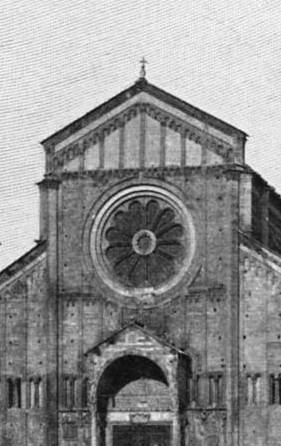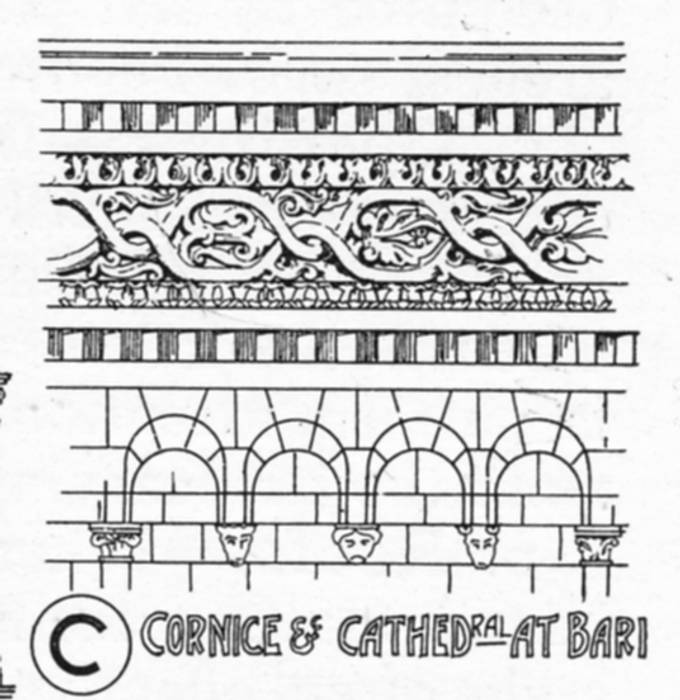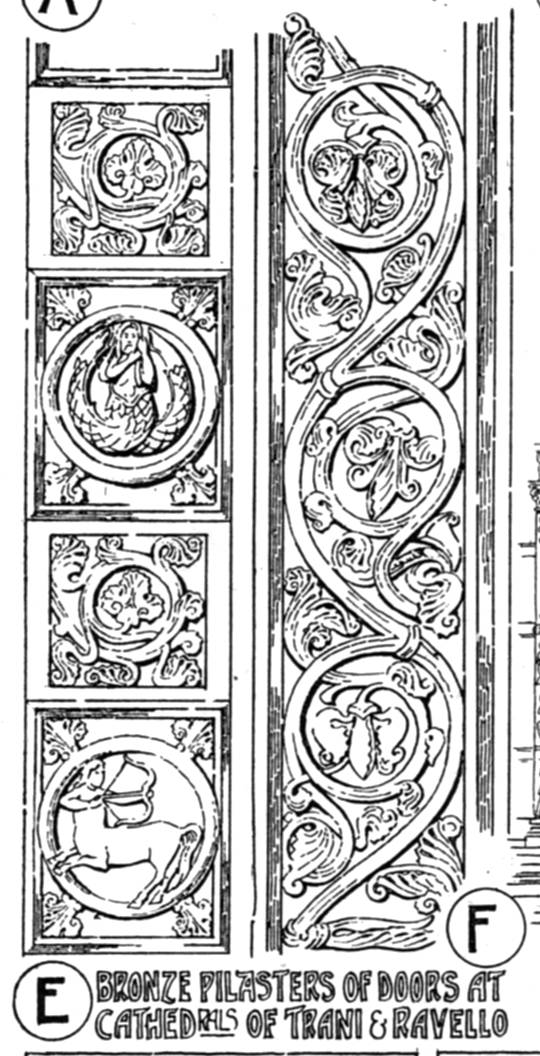Plans

Monreale Cathedral, Sicily. No. 97. [Click on image to enlarge it.]
The plans of most of the churches were substantially the same as the basilicas, more especially in Central Italy; in the North the churches are mostly vaulted, modifications being introduced on the lines of German work; in the South, the low lanterns at the crossing, oblong in plan, are marked features, as at Monreale Cathedral (No. 97). The choir was occasionally raised to admit of a crypt beneath, reached by steps from the nave. A number of circular examples were built mainly as baptisteries, that at Novara being connected to the cathedral by an atrium. There is a fine atrium at S. Ambrogio, Milan. In the North the open arcades of the apses seen in conjunction with the usual arcaded octagonal lantern at the crossing, constitute the charm of the style. Projecting porches were preferred to recessed doorways, and are bold open-arched structures, often of two stories, resting on isolated columns, and placed on huge semi-grotesque lions, having a symbolic character. Towers, as at Piacenza and S. Zenone, Verona (No. 96), are detached, being straight shafts without buttresses or spires, which, when occurring, can be traced to German influence.
Walls
The flat blind arcades of the northern style were developed by the Pisan (Central) architects in their galleried facades. The west front, including the aisles, was carried up to a flat gable, with arcading following the rake, and other arcades carried across in bands. The Northern facades are flatter, and sometimes have a large circular window to light the nave. In the South this feature is highly elaborated with wheel tracery, as in the churches at Palermo. Flank walls are occasionally decorated by flat pilaster strips, connected horizontally by small arches, springing from corbels (No. 98c).




Left two: Stand-alone tower (campanile) and wheel window at San Zenone, Verona. Plate 96. (c) Cornice of Cathedral at Bari. Plate 98c. (d) Doorway, San Clemente, Rome. Plate 98a. [Click on these images for larger pictures.]
Openings
In consequence of the bright climate the openings are small (No. 98a), and opaque decoration was preferred to translucent. Window tracery was not developed. The wheel windows (No. 96; see above) just described are only rudimentary in pattern, attention being chiefly bestowed upon their decoration, as in the rich carving of the Palermo examples.
Roofs
Where round-arched cross vaulting, or simple barrel vaults, were not employed, the timber roofs of the basilican style often effectively decorated with color were used. In the southern examples, domes rather than vaults were attempted, but timber roofs are the rule in Palermo and Monreale (No. 97; above at top), and, owing to Mahometan influence, great richness in timber ceilings was attained. The nave roofs of Italian churches continued to-be constructed of wood with flat ceilings till the thirteenth century. Plain groined vaults of small span were common and divided into compartments=s by flat bands, a practice which was continued into the Gothic period.
Columns
Piers with half shafts were employed rather than columns, especially in the North, where vaulting was more m use, but coupled and grouped shafts were seldom properly developed in relation to the vaulting ribs. Buttressing was obtained by means of the division walls between an outer range of chapels, more often than not unmarked on the exterior. In Central Italy, as at Toscanella rude Corinthian columns carry a round-arched arcade, above which the plain walls are pierced, by the small arched openings of the clerestory, while the roof is of the simple basilican type No. 98j-m, show typical capitals.

Mouldings
Flat bands are characteristic of the Northern style. Strings were formed by small arches, connecting one pilaster strip to another. Rude imitations of old Classical detail are met with. Southern work is far superior in detail, often possessing good outline, grace, and elegance. Richness and elaboration were attempted in the doorways (No. 94h: below & 98j: immediately above).
Ornament



Left: Bishop's Throne, St. Michael's Church, Monte S. Angelo. Plate 98h. Middle: Bronze pilasters of doors at cathedrals at Trani and Ravello. Plate 98e&f. Right: Arches of the Apse of the Duomo, Pisa by John Ruskin. [Click on these images for larger pictures.]
(No. 98).—Roughly carved grotesques of men and animals (No. 98e & f), vigorous hunting scenes, and incidents of daily life are found in Northern sculpture. In Central Italy greater elegance is displayed, and Classic models, were copied. The rows of apostles on the lintels of the doorways, as at Pistoia, are similar in treatment to Byzantine ivories. In Southern examples, bronze doors are a feature, as at Monreale Cathedral. Elaborate decoration in mosaic exists as in the Palermo churches and elsewhere (No. 98h), and the use of color was the main object in the design of the interiors.
Related Material
References
Fletcher, Banister, and Banister F. Fletcher. A History of Architecture on the Comparative Method for the Student, Craftsman, and Amateur. 5th ed. London: B. T. Batsford, 1905.
Last modified 9 March 2014